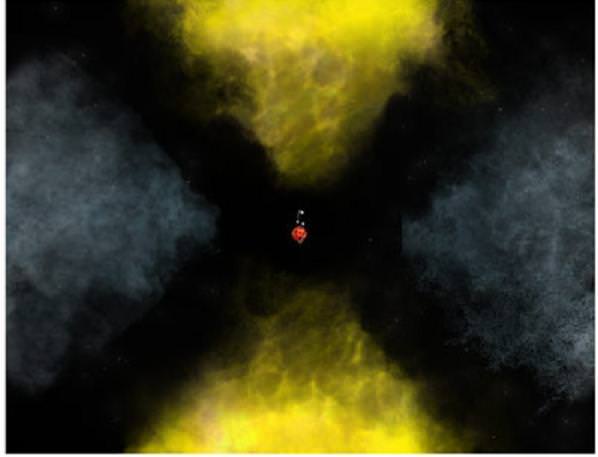Over two years ago, the Fermi-LAT Collaboration observed an “ear and eye opening” event – the exact location where a stellar explosion called a nova emitted one of the most energentic forms of electromagnetic waves… gamma rays. When it was first detected in 2012, it was something of a mystery, but the findings could very well point to what may cause gamma ray emissions.
“We not only found where the gamma rays came from, but also got a look at a previously-unseen scenario that may be common in other nova explosions,” said Laura Chomiuk, of Michigan State University.
A nova? According to the Fermi researchers, a classical nova results from runaway thermonuclear explosions on the surface of a white dwarf that accretes matter from a low-mass main-sequence stellar companion. As it gathers in material, the thermonuclear event expels debris into surrounding space. However, astronomers didn’t expect this “normal” event to produce high energy gamma rays!
Explains the Fermi-LAT team: “The gamma-ray detections point to unexpected high-energy particle acceleration processes linked to the mass ejection from thermonuclear explosions in an unanticipated class of Galactic gamma-ray sources.”
While NASA’s Fermi spacecraft was busy watching a nova called V959 Mon, some 6500 light-years from Earth, other radio telescopes were also busy picking up on the gamma ray incidences. The Karl G. Jansky Very Large Array (VLA) was documenting radio waves coming from the nova. The source of these emissions could be subatomic particles moving at nearly the speed of light interacting with magnetic fields – a condition needed to help produce gamma rays. These findings were backed up by the extremely-sharp radio “vision” of the Very Long Baseline Array (VLBA) and the European VLBI network. They revealed two knots in the radio observations – knots which were moving away from each other. Additional studies were done with e-MERLIN in the UK, and another round of VLA observations in 2014. Now astronomers could begin to piece together the puzzle of how radio knots and gamma rays are produced.
According to the NRAO news release, the white dwarf and its companion give up some of their orbital energy to boost some of the explosion material, making the ejected material move outward faster in the plane of their orbit. Later, the white dwarf blows off a faster wind of particles moving mostly outward along the poles of the orbital plane. When the faster-moving polar flow hits the slower-moving material, the shock accelerates particles to the speeds needed to produce the gamma rays, and the knots of radio emission.
“By watching this system over time and seeing how the pattern of radio emission changed, then tracing the movements of the knots, we saw the exact behavior expected from this scenario,” Chomiuk said.

But the V959 Mon observations weren’t the end of the story. According to Fermi-LAT records, in 2012 and 2013, three novae were detected in gamma rays and stood in contrast to the first gamma-ray detected nova V407 Cygni 2010, which belongs to a rare class of symbiotic binary systems. Despite likely differences in the compositions and masses of their white dwarf progenitors, the three classical novae are similarly characterized as soft spectrum transient gamma-ray sources detected over 2-3 week durations.
“This mechanism may be common to such systems. The reason the gamma rays were first seen in V959 Mon is because it’s close,” Chomiuk said. Because the type of ejection seen in V959 Mon also is seen in other binary-star systems, the new insights may help astronomers understand how those systems develop. This “common envelope” phase occurs in all close binary stars, and is poorly understood. “We may be able to use novae as a ‘testbed’ for improving our understanding of this critical stage of binary evolution,” explains Chomiuk.
Original Story Source: Radio Telescopes Unravel Mystery of Nova Gamma Rays from National Radio Astronomy Observatory. Chomiuk worked with an international team of astronomers. The researchers reported their findings in the scientific journal “Nature”.


Dear Tammy Plotner, I’d like you to clarify your phrase: “one of the most energentic forms of electromagnetic waves… gamma rays.” Not the typo in “energentic” but what may possibly be more energetic than gamma rays, as can be infered by what you wrote.
Thanks!